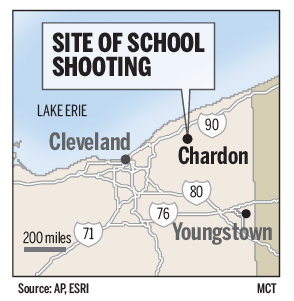Area school chiefs assess plans after Chardon tragedy
By Denise Dick
Youngstown
School crisis plans and safety precautions are in place, but Mahoning Valley superintendents say building relationships with students is the best way to guard against a Chardon-like tragedy.
A student is in custody Monday morning, suspected of opening fire inside the Geauga County high school cafeteria before the start of the Monday school day. One student was killed, and at least four others were injured.
Howard Friend, superintendent of Sebring schools, said that school district takes precautions to try to guard against similar incidents.
“You can never be too careful,” Friend said.
All of the doors to school buildings are locked, and visitors must be buzzed in. At the start of the school day, all students enter through the same door.
“We have practice lockdowns several times per year,” he said, when doors to all classrooms are locked from the inside.
“We’re very fortunate with the size school that we are, the administrators and teachers know the kids and have a good relationship with them,” Friend said.
The U.S. Secret Service and U.S. Department of Education studied 37 incidents involving 41 school attacks that had occurred between 1974 and 2000 and determined that school attacks are rarely impulsive.
One recommendation from that study was that schools form multidisciplinary threat-assessment teams to assist with identifying, assessing and managing students who may pose a threat of targeted violence.
Girard Superintendent David Cappuzzello said school personnel know warning signs to look for in students. If a student exhibits behavior that raises a red flag, school counselors initially try to meet with the student. The school principal may get involved, and the school district contacts parents in incidents to secure an appointment with an outside agency if necessary.
In the most severe cases, a student may not be permitted to return to school until a psychiatric evaluation is completed, Cappuzzello said.
Girard schools work with city police to practice lockdown procedures, and the school buildings are equipped with door buzzers to restrict access and cameras to monitor activities.
But area superintendents acknowledge those safeguards are limited.
“We all plan for the outside person coming in,” Cappuzzello said.
If the shooter is a student as was the case in Chardon, Columbine and other high-profile school shootings, “... they know the lockdown procedures, they know where the students are supposed to go,” he said.
Youngstown’s high and middle schools are equipped with metal detectors that everyone entering the buildings, including students, must pass through. But Superintendent Connie Hathorn said the district also relies on students and the community to alert school personnel if something happens outside of school that could spill into the buildings.
That’s particularly useful after weekends. The district also has a crisis hot line that students may call anonymously with problems.
“A lot of times, kids feel safer in school than they do when they’re in their neighborhoods on the weekends,” Hathorn said.
Police officers also work in the buildings to address problems that may occur.
Austintown also practices lockdown drills with help from township police. All classrooms are locked, and students go to an area of the room where they can’t be seen through a window and remain quiet. They’ve been instructed not to open the door or answer if someone knocks, said Superintendent Vince Colaluca.
Teachers, counselors and administrators also have been trained to spot warning signs, he said.
“The biggest piece is making students feel welcome and a part of the school system,” Colaluca said. “We emphasize treating them as customers.”
There are programs in place, for example, to help students as they transition among grades or buildings. Dealing with bullying issues also is a piece, he said.
In Springfield schools, students and staff are trained in ALICE (Alert, Lockdown, Information, Counter and Evaluation).
“Sometimes we have an opportunity to escape or fight back, but training tells us to lock down, shut down and hide under a desk,” said Debra Mettee, Springfield superintendent.
ALICE trains students and school personnel to look for those opportunities to escape.
“Our school resource officer [New Middletown Sgt. Ken Goist] is really cutting-edge,” Mettee said.
During the training, school personnel saw a video simulation of the 1999 Columbine High School shooting in Colorado during which gunmen picked off, one by one, students who sought refuge under desks.
ALICE encourages students to run in different directions if they see an opportunity to escape. Running in different directions makes it more difficult for a shooter to hit students.
Mettee also said having a school resource officer who’s been in the district a long time helps generate tips about possible problems that may arise at school. Students and parents are comfortable speaking to him, she said.
“It’s about openness of communication,” Mettee said. “Teachers have to be comfortable talking to students, to principals, the school resources officer.”
And students have to be comfortable talking to the officer, their teachers, principal or their parents, she said.
“Everyone wants to be safe,” Mettee said.
Frank Lazzeri, Boardman superintendent, said that district also works closely with police and maintains a crisis plan.
But he believes a key to discouraging such incidents is by building relationships with students.
Earlier this month, a high school student was accused of bringing an unloaded gun to school. Other students became aware of it and reported it to school security.
“I have to commend our students,” Lazzeri said. “They want to keep Boardman schools a safe place to be educated. They’ll tell people when things aren’t quite right.”
Students are the first line of defense if, for example, a classmate is posting to a social-media site about something that raises concerns.
“It’s about building relationships with students,” Lazzeri said. “You have to make staff aware of signs of behavior that isn’t normal, telling students that they are part of the safety program also, to alert faculty, administrators or parents when something is going on that makes them not feel comfortable.”
 43
43

